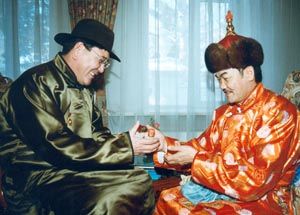Archive for the 'Nomadic Culture' Category
 Like the Chinese, the Mongolians use a lunar calendar to celebrate traditional holidays, such as the lunar new year. Years are traditionally grouped into five blocks of 12 years. Each block is named after one of the elements (Earth, fire, water etc) and each year is named after the 12 animals of the zodiac.
Like the Chinese, the Mongolians use a lunar calendar to celebrate traditional holidays, such as the lunar new year. Years are traditionally grouped into five blocks of 12 years. Each block is named after one of the elements (Earth, fire, water etc) and each year is named after the 12 animals of the zodiac.Nomads divide winter into periods of time in multiples of nine, the lucky number for Buddhists. The winter is 81 days long (nine times nine). At the end of the 81st day, Tsagaan Sar (White Month), is widely celebrated as the start of the lunar new year.
Government offices are usually open from 9 am to 5 pm on weekdays and lunch hour is 1 pm to 2 pm. Banks are supposed to open from 10 am to 3 pm weekdays. Mongolia introduced a five-day working week in 1998. Most private and state-run businesses open at about 10 am and close sometime between 5 and 8 pm. In the countryside most guanz: (canteens) seem to close for dinner (and often lunch as well). In reality, opening hours are often at the whim of staff. Readmore…
 Tsagaan Sar is the Mongolian lunar New Year’s festival. It is often celebrated around the same time as the Chinese New Year. However, Mongolians generally deny any Chinese origin or influence, so the celebration is sometimes referred to as the Mongolian New Year or Asian New Year when translated into English.
Tsagaan Sar is the Mongolian lunar New Year’s festival. It is often celebrated around the same time as the Chinese New Year. However, Mongolians generally deny any Chinese origin or influence, so the celebration is sometimes referred to as the Mongolian New Year or Asian New Year when translated into English.
The White Moon holiday is celebrated two months after the first new moon following the winter solstice. In 2008, White Moon falls on Feb. 8th. After Naadam, Tsagaan Sar is the second-most important Mongolian holiday. Around the New Year people greet each other by saying “Amar mend uu”, a very formal greeting which one says to one’s elders. Mongolians also visit friends and family on this day and exchange gifts. Readmore…
{mosimage}National Great Holiday Nauryz of Kazakh people, who have ancient traditional culture and custom of Asia and nomads, is launching in Mongolia. The holiday, marks traditionally on 22, March every year, is very special holiday. Since 1990, Kazakh people have been celebrating widely Nauryz. Also, their great movement began in this year. Over 65 thousand citizens have moved to Kazakhstan since 1990.
commercial dictionary software for Uighur-script and Cyrillic Mongolian
in the world. The culmination of over four years of work, it has been
designed to work on all Windows-based operating systems without the
need to change System Locales or download and install any fonts.
People who are very strict Mongolian traditionalists, let the special
person called “yaschin” (bone man) to enter first to fix the body of
the dead for burial. They prohibit to let others (outsiders or
strangers) enter into the room or place (could be morgue) where the
dead is placed.
Readmore…
{mosimage}
A round wooden-framed felt tent covered in durable while canvas seems
to be the most simple description of this portable home, familiar to
many from Russian word yurt. The modern shape of the Mongolian ger has
been formed as the result of a long development from huts, marquees and
wheeled abodes.
It is important to select a good site that has good, dry soil. The
surface of the ground must be even. Before the floor is laid the soil
must be shoveled in order to loosen and even it out. Mongolians always
put up their yurts with the door facing south. By doing this they can
use the roof ring, along with the sun to effectively tell time.
{mosimage}The Mongolian yurt has passed through many different stages during its
development process. It has been improved by people with various
intellectual levels over many generations beginning with the wooden
dwelling built by ancient man. Even in the rock paintings left by
ancient men in Mongolia, early dwelling evolution can be seen.
Readmore…
Yurt is one type of the human housing. Scientists consider that
separation between nomadic herder tribes and hunter tribes was the main
reason of the origin of Yurt. Most scientists who made studies on yurt
hardly tried to reveal differences and similarities of demands of use
yurt, traditional features of people who lived in yurt, their relations
and distribution of yurt shaped residences.








Recent Comments